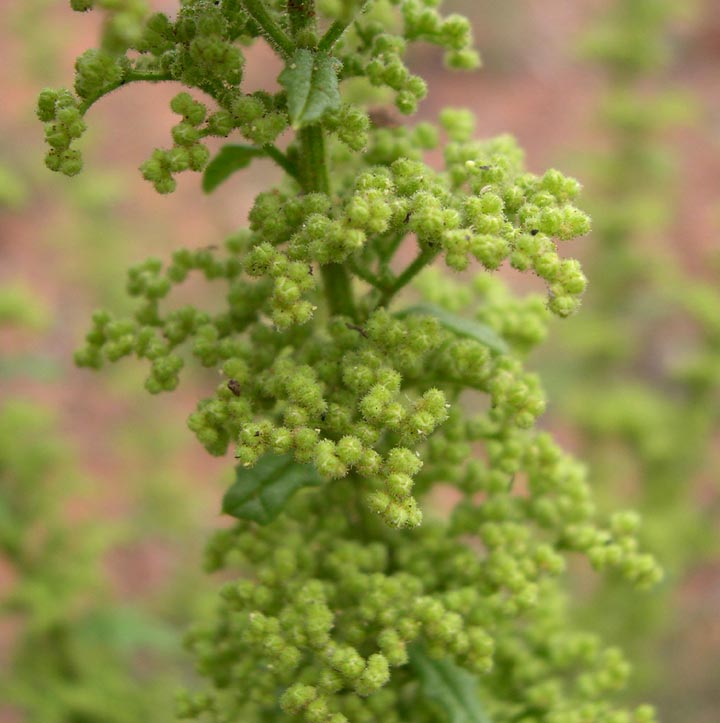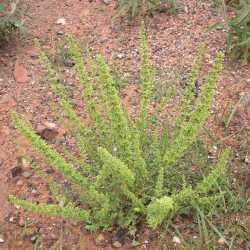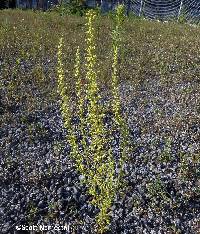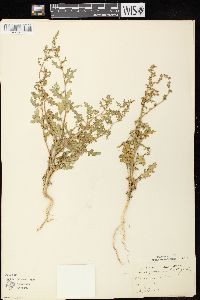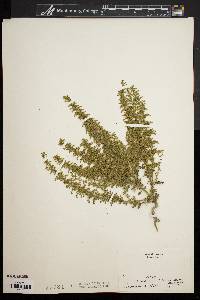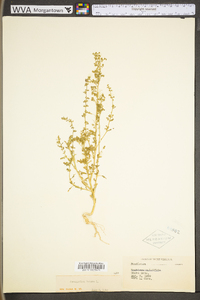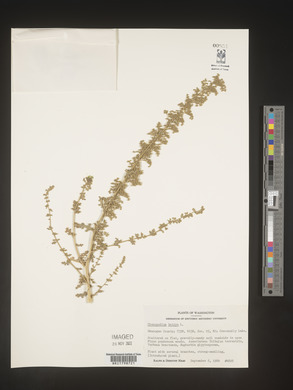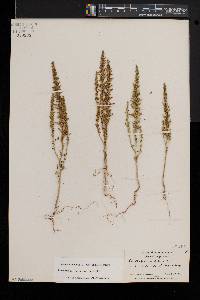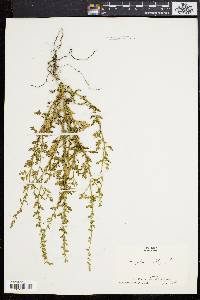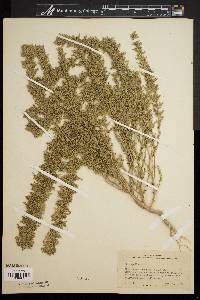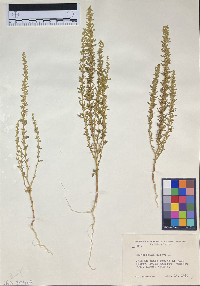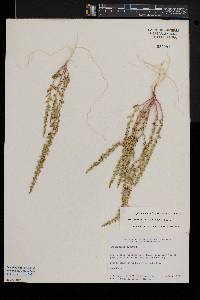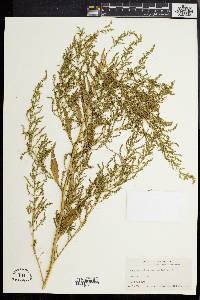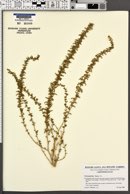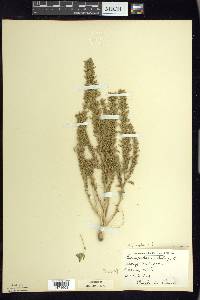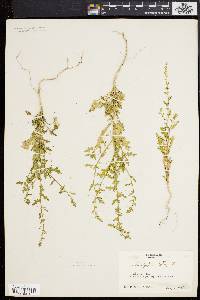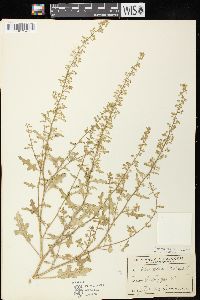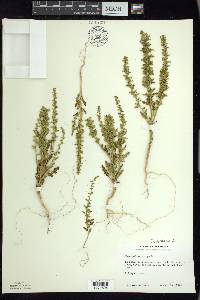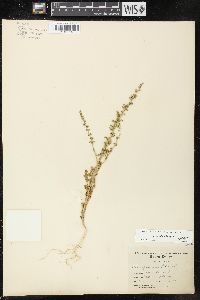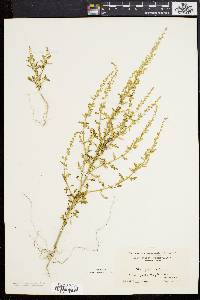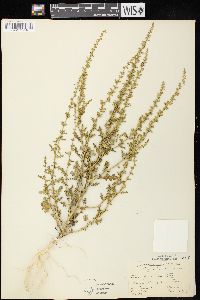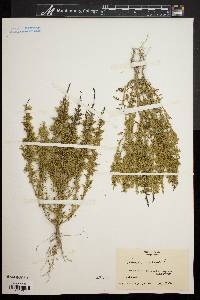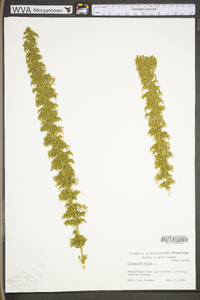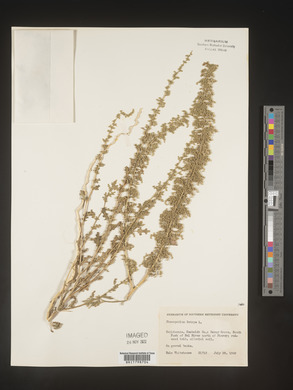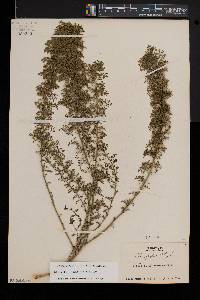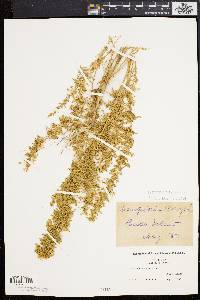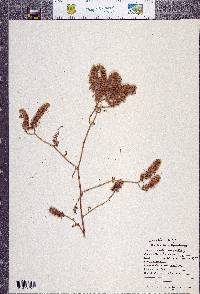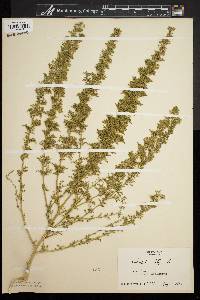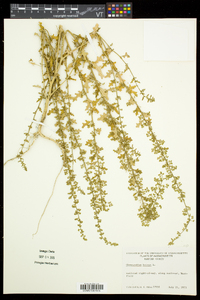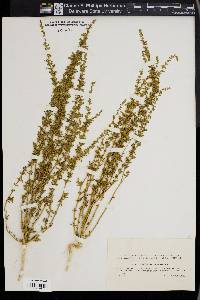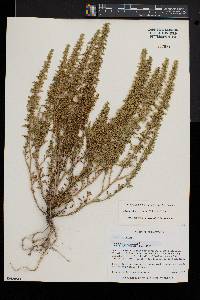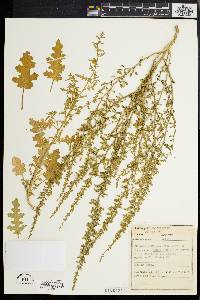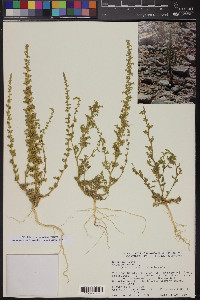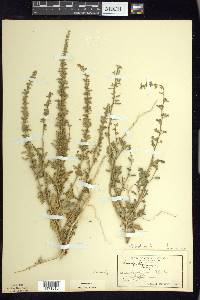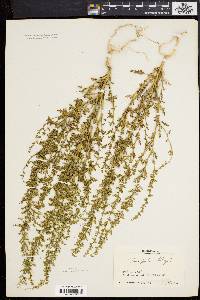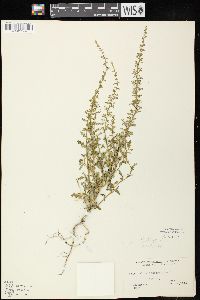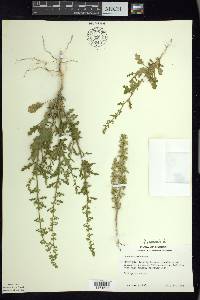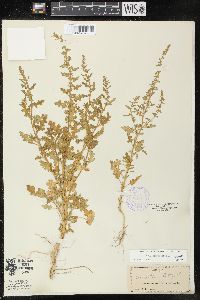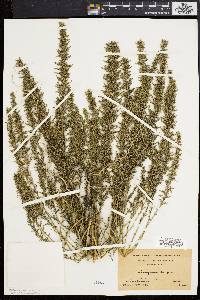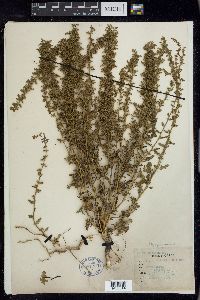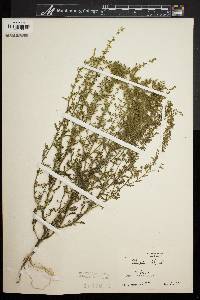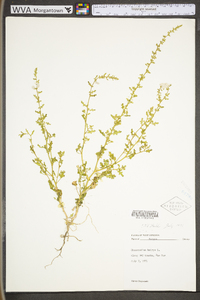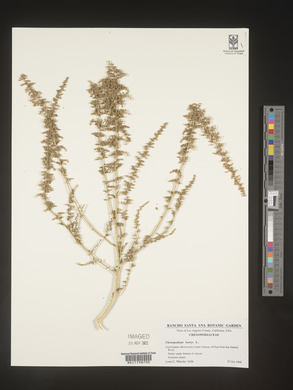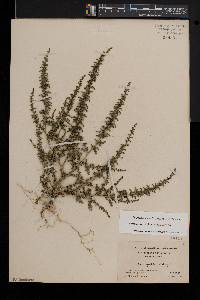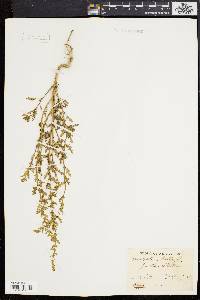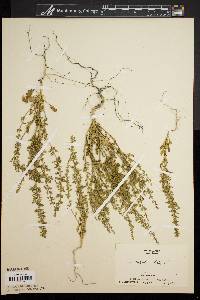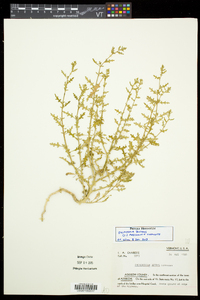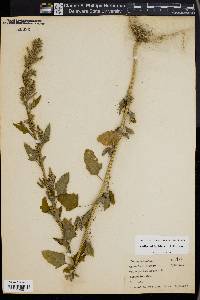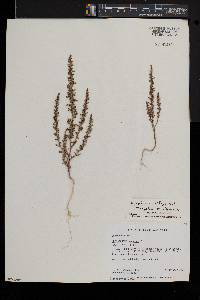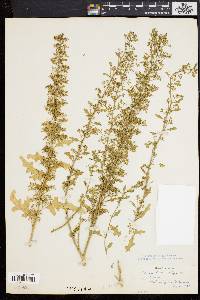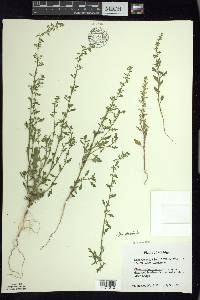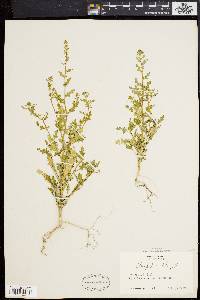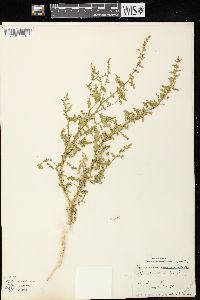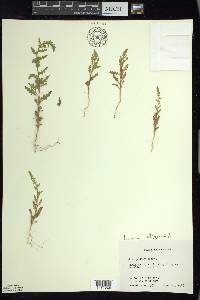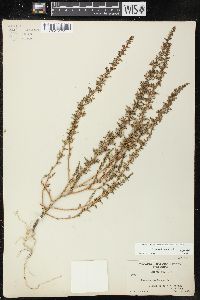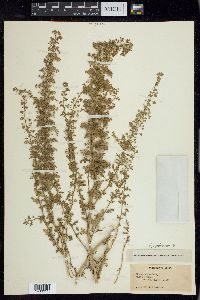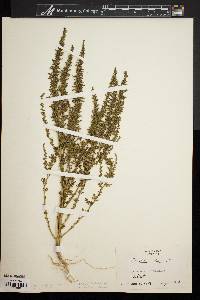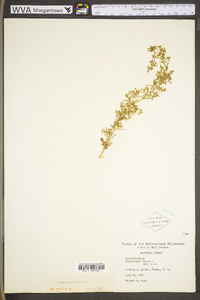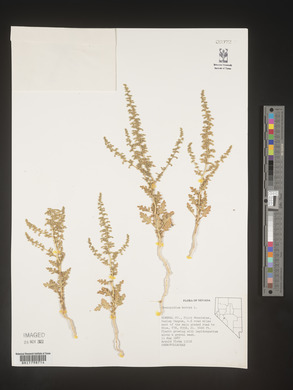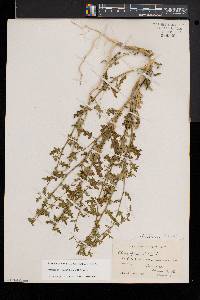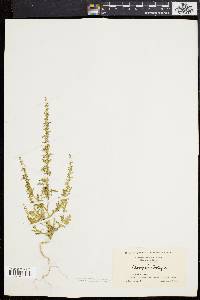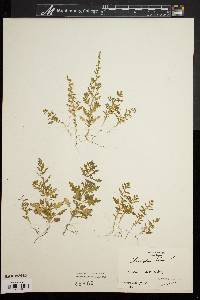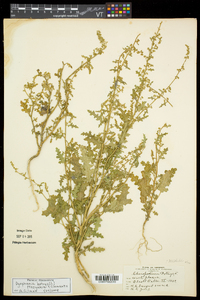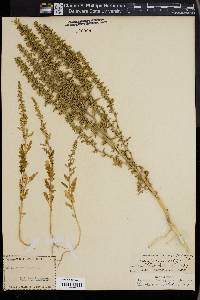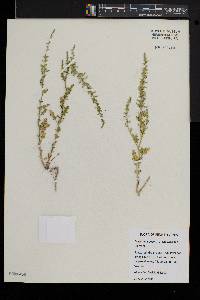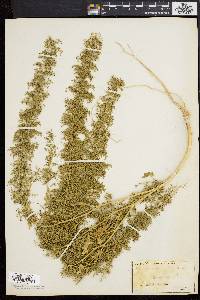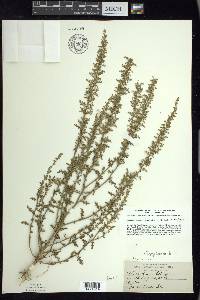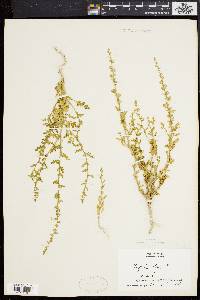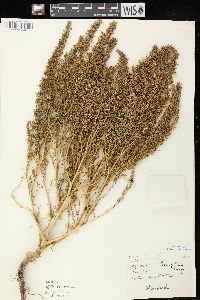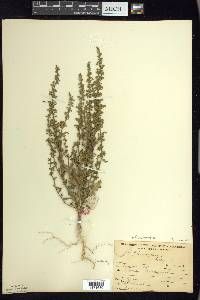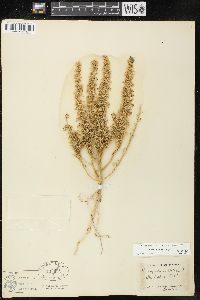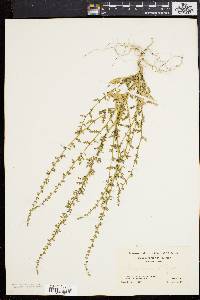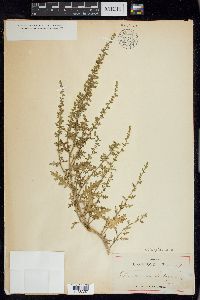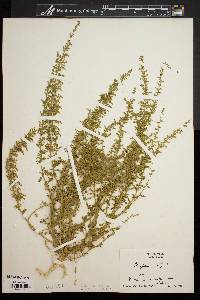Dysphania botrys
|
|
|
|
Family: Amaranthaceae
Jerusalem-Oak
[Botrydium botrys (L.) Small, moreChenopodium botrys L., Chenopodium nepalense Moq., Teloxys botrys (L.) W.A. Weber] |
Stems erect to ascending, branched at base to ± simple, 1-6(-10) dm, pubescent with short-stalked glandular hairs. Leaves aromatic; petiole to 2.5 mm; blade 1.3-4 × 0.6-2.7 cm, base cuneate, margins lyrate-sinuate, pinnatifid, or occasionally entire (in distal leaves), apex acute to subobtuse, glandular-pubescent abaxially. Inflorescences axillary cymes, often arranged in terminal thyrses, 12-24 cm, subtended by cauline leaves; bracts absent. Flowers: perianth segments 5, distinct nearly to base, distinct portion elliptic or ovate to oblong, 0.7-1.1 × 0.5-0.7 mm, apex acute to obtuse, rounded abaxially, densely glandular-pubescent, covering fruit at maturity; stamens 1-3(-5); stigmas 2. Achenes subglobose; pericarp adherent, membranaceous, papillose, becoming rugose, usually white-blotchy. Seeds globose to subglobose, (0.5-) 0.6-0.8 × 0.5-0.7 mm, margins rounded (rarely indistinctly furrowed); seed coat rugose. 2n = 18. Fruiting Aug-Oct. Sandy or gravelly soils, dry rocky ridges and cliffs, mud flats, waste places; 0-2000 m; introduced; B.C., N.B., N.S., Ont., P.E.I., Que.; Ariz., Calif., Colo., Conn., Del., Idaho, Ill., Ind., Iowa, Kans., Ky., La., Maine, Md., Mass., Mich., Minn., Mo., Mont., Nebr., Nev., N.H., N.J., N.Mex., N.Y., N.C., N.Dak., Ohio, Oreg., Pa., R.I., S.Dak., Tex., Utah, Vt., Va., Wash., W.Va., Wis., Wyo.; s Europe, s, c, se Asia. Dysphania botrys is related to a species from Africa and southern Eurasia, D. schraderiana (Schultes) Mosyakin & Clemants, which may occur locally in North America as introduced. Dysphania schraderiana has distinctly keeled perianth segments with mostly sessile or subsessile glands. The general inflorescence in D. schraderiana is usually leafy almost to the top, distal cauline leaves are similar to proximal ones (in D. botrys distal leaves are normally much reduced, and the distal portion of the general inflorescence appears nearly leafless). H. A. Wahl (1954) reported that D. schraderiana (as Chenopodium schraderianum) had been grown in Ontario. He did not indicate that it had escaped.
Annual herb 20 cm - 0.6 m tall Stem: glandular-hairy. Leaves: alternate, stalked, to 8 cm long, oblong to egg-shaped, more or less pinnately lobed and wavy, glandular-hairy. Upper leaves smaller and somewhat less deeply divided. Inflorescence: a small, lateral cluster of flowers (cyme), numerous, along the main axes, together forming long, slender, terminal inflorescences. Flowers: greenish, small, with five nearly distinct sepals and no petals. Sepals glandular-hairy. Stamens five. Stigmas two. Fruit: one-seeded, enclosed in the persistent, incurved sepals, thin-walled. Seed horizontal or sometimes upright, blackish, 0.6 - 0.8 mm wide, thickly lenticular (lens-shaped), without margins. Similar species: No information at this time. Flowering: mid-June to late September Habitat and ecology: Introduced from Eurasia. Characteristically found in cinder flats. Also found in the cinder ballast of railroads. Occurence in the Chicago region: non-native Etymology: Chenopodium comes from the Greek words chen, meaning goose, and podion, meaning "little foot," referring to the leaf shape of some species. Botrys means "cluster of grapes," referring to the inflorescence. Author: The Morton Arboretum Annual 2-6 dm, pubescent with short glandular hairs, strongly but not unpleasantly aromatic; lvs oblong to ovate, the lower to 8 cm, sinuate-pinnatifid, the upper much smaller, pinnatilobate to entire; fls in numerous small lateral cymes along the main axes, forming long, slender, terminal infls; cal deeply 5-lobed, glandular-hairy, the segments rounded on the back; seeds horizontal or some of them erect, dull blackish, 0.6-0.8 mm wide, thick- lenticular, not margined; 2n=18. Native of Europe, established as a weed in waste places in our range. C. graveolens Willd., a native of sw. U.S. and trop. Amer., with the cal beset with yellow glands, the segments at maturity developing a conical tubercle on the back near the top, is rarely adventive in our range. Gleason, Henry A. & Cronquist, Arthur J. 1991. Manual of vascular plants of northeastern United States and adjacent Canada. lxxv + 910 pp. ©The New York Botanical Garden. All rights reserved. Used by permission. From Flora of Indiana (1940) by Charles C. Deam Introduced in America. It grows on sandy hills, in open woods, and similar habitats. ...... Indiana Coefficient of Conservatism: C = null, non-native Wetland Indicator Status: FACU ...... Indiana Coefficient of Conservatism: C = null, non-native Wetland Indicator Status: FAC Diagnostic Traits: plants with glandular-tipped hairs, aromatic; lower leaves sinuate-pinnatifid; flowers in branched cymes, loose, leafless; fruits horizontal or vertical, about 0.5-0.6 mm long. |

